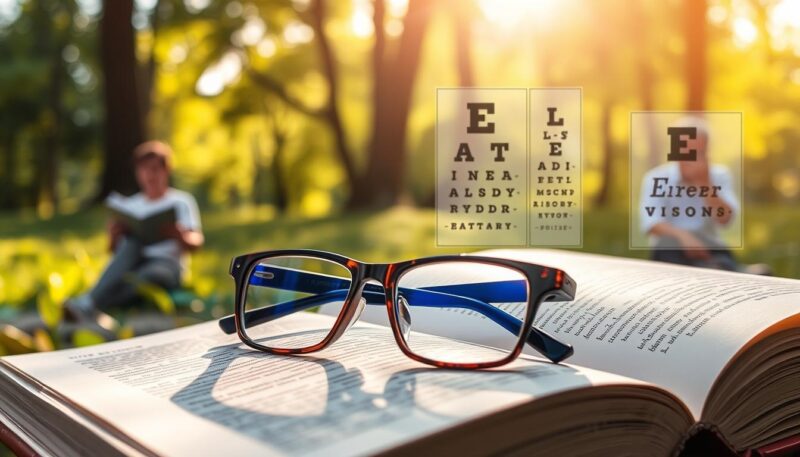Recognizing the signs you need glasses can be crucial for maintaining good vision health. Many people experience symptoms needing glasses without realizing it, which can lead to further vision problems if left unaddressed. By being aware of the common signs and symptoms, such as blurry vision, eye strain, and difficulty seeing at night, you can take the first step towards improving your vision and overall eye health.
Regular comprehensive eye exams for adults are recommended at least once a year, and it is essential to have your eyes checked at least every two years or more frequently if you notice changes in your vision. This can help identify vision health tips and provide early detection of eye diseases, accurate prescriptions, and assessment of overall eye health. Family history significantly increases the likelihood of developing myopia or hyperopia, so it’s crucial to discuss your vision concerns with a professional.
Difficulty reading can be a common symptom of presbyopia associated with aging, and double vision could be a sign of an underlying health condition or eye problem. Headaches related to vision strain can be a common occurrence, and blurry vision is one of the primary signs that may indicate a need for glasses. By understanding these signs and symptoms, you can take proactive steps towards maintaining good vision health and addressing any potential issues before they become severe.
Common Signs and Symptoms That Indicate You Need Glasses
Identifying vision problems early on is crucial to prevent further complications. To learn how to identify poor eyesight, it’s essential to recognize common eye health issues. When to see an optometrist is a question many people ask, and the answer lies in being aware of the signs and symptoms that indicate a need for glasses.
Some common signs of vision problems include blurry vision, eye strain, and headaches. These symptoms can be caused by various factors, such as extensive computer use, poor lighting, or underlying medical conditions. To understand how to identify poor eyesight, it’s crucial to be aware of these signs and take action when necessary.
Here are some common signs and symptoms that may indicate you need glasses:
- Squinting at the computer screen or when watching TV
- Struggling to see at night or in low-light conditions
- Experiencing eye strain or fatigue after using digital devices
- Frequent headaches or soreness in the neck and shoulders
These symptoms can be a sign of underlying vision problems, such as nearsightedness, farsightedness, or astigmatism. When to see an optometrist is when you experience any of these symptoms regularly. By being aware of common eye health issues and knowing how to identify poor eyesight, you can take the necessary steps to correct your vision and improve your overall eye health.
Don’t ignore these signs and symptoms. If you’re experiencing any of them, it’s time to schedule an eye exam with an optometrist. They can help you determine the cause of your vision problems and provide the necessary treatment to correct your vision.
| Common Signs and Symptoms | Possible Causes |
|---|---|
| Blurry vision | Nearsightedness, farsightedness, astigmatism |
| Eye strain | Extensive computer use, poor lighting, underlying medical conditions |
| Headaches | Frequent headaches or soreness in the neck and shoulders |
How Your Daily Activities Might Be Affected by Poor Vision
Poor vision can significantly impact your daily activities, making it essential to identify the symptoms and take corrective measures. If you’re experiencing do I need glasses symptoms, it’s crucial to prioritize your vision health. Simple tasks like reading, driving, or using digital devices can become challenging, leading to frustration and decreased productivity.
According to vision health tips, regular eye exams can help detect potential issues early on, preventing more severe problems. By learning how to identify poor eyesight, you can take proactive steps to address any vision-related concerns. For instance, if you’re struggling with blurred vision or eye strain, it may be a sign that you need glasses or corrective lenses.

Some common signs that your daily activities are being affected by poor vision include:
- Difficulty reading or watching TV due to blurred vision
- Struggling to drive at night or in low-light conditions
- Experiencing eye fatigue or headaches when using digital devices
By recognizing these symptoms and taking action, you can improve your overall quality of life and maintain good vision health. Remember, early detection and correction are key to preventing more severe vision problems.
Prioritizing your vision health is essential for maintaining your overall well-being. By staying informed and taking proactive steps, you can ensure that your daily activities are not hindered by poor vision.
How to Tell If You Need Glasses: Self-Assessment Guide
Identifying symptoms needing glasses can be crucial in maintaining good eye health. Common signs you need glasses include blurred vision, difficulty reading, or seeing objects up close. If you experience these signs, it may be time to consider a self-assessment guide to determine if you need glasses.
Regularly monitoring your vision for common eye health issues can help you identify potential problems early on. This can include paying attention to changes in your vision, such as difficulty seeing distant objects or struggling to read.
Distance Vision Problems to Watch For
Distance vision problems can be a sign that you need glasses. If you find it challenging to see objects or read signs from a distance, it may be a symptom of a underlying vision problem.
Near Vision Warning Signs
Near vision warning signs, such as struggling to read or see objects up close, can also indicate that you need glasses. If you experience these symptoms, it is essential to consult with an eye care professional to determine the best course of action.

| Common Vision Problems | Symptoms |
|---|---|
| Myopia (nearsightedness) | Difficulty seeing distant objects |
| Hyperopia (farsightedness) | Difficulty seeing objects up close |
| Astigmatism | Blurred vision at all distances |
By being aware of these common eye health issues and taking the necessary steps to address them, you can maintain good eye health and prevent potential vision problems.
Taking Action: When to Schedule Your Eye Exam
If you’ve been experiencing vision-related symptoms, such as frequent headaches, blurred vision, or difficulty seeing at night, it’s time to schedule an eye exam with an optometrist. Regular eye checkups, typically every 1-2 years for adults, can help identify and address any underlying vision problems early on. Don’t wait until your vision significantly deteriorates – proper vision health is crucial for your overall well-being.
During the eye exam, your optometrist will assess your visual acuity, eye coordination, focusing abilities, and eye pressure to detect any issues like nearsightedness, farsightedness, or glaucoma. They may also recommend corrective lenses or specialized glasses, such as blue-light glasses, to alleviate symptoms of digital eye strain. If more advanced treatment is required, your optometrist can provide a referral to an ophthalmologist for further evaluation and care.
Remember, prioritizing your vision health can make a significant difference in your daily life. So, don’t hesitate to schedule your eye exam and take the necessary steps to maintain clear, comfortable vision. With the right care and attention, you can enjoy the world around you to the fullest.
